Abstract
Background/Aims
Peroral endoscopic myotomy (POEM) is a novel procedure for the treatment of achalasia and spastic esophageal disorders. Experience with POEM is limited, but its reported outcomes are excellent. It is deemed safe even for patients with prior interventions.
Methods
This retrospective review included patients who underwent POEM at a tertiary US center. POEM was performed in a multidisciplinary approach by advanced endoscopists and foregut surgeons. Clinical success was defined as a post-POEM Eckardt score ≤3.
Results
A total of 125 patients were included. Median follow-up period was 18 months (interquartile range, 10–22 months). Clinical success was achieved in 92% of patients and persisted at 12 months in 88% of patients. Mucosal barrier failure (MBF) occurred in 7 patients, 2 of whom required surgical intervention. MBF was more common in patients with prior laparoscopic Heller myotomy (19% vs. 3%, p=0.015). MBF requiring surgical intervention occurred early in the learning curve.
Go to : 
Achalasia is a rare esophageal motility disorder that results from the progressive loss of function of inhibitory ganglion cells in the myenteric plexus [1,2]. Failure of the lower esophageal sphincter to relax along with ineffective peristalsis leads to progressive dysphagia. Treatment for achalasia aims to reduce the resting lower esophageal sphincter pressure to decrease resistance to the passage of an ingested food bolus.
Durable symptom relief requires disruption of the circumferential muscle layer at the lower esophageal sphincter. This can be achieved through endoscopic pneumatic dilation (PD) or laparoscopic Heller myotomy (LHM). Improvements in dysphagia achieved with PD and LHM are comparable. However, PD may require multiple treatment sessions with each intervention carrying a 1%–6% risk of perforation [3,4].
Peroral endoscopic myotomy (POEM) is a less invasive alternative to LHM. Initial reports of POEM are promising [5], but experience in the US remains limited, while uncertainty remains regarding the durability of the treatment effect. Our initial experience with 31 POEM patients [6] was reported with regard to safety and efficacy. This is a report on the on feasibility, efficacy, safety, and durability of POEM for achalasia and spastic esophageal motility disorder at a US tertiary care center.
Go to : 
We completed a retrospective chart review of all patients who underwent POEM between November 2013 and January 2018.
The procedure was performed in the operating room under general anesthesia by a therapeutic endoscopist (REA and HG) and a surgeon (PN, JK and KP).
POEM was offered to patients with symptomatic achalasia and esophagogastric junction outflow obstruction (EGJOO). It was selectively considered for patients with spastic esophageal disorders (distal esophageal spasm [DES], jackhammer esophagus) presenting with dysphagia as the predominant complaint. An endoscopic approach was used in treatment-naïve patients as well as those with prior interventions including LHM, PD, and botulinum toxin injections who had persistent or recurrent symptoms (Fig. 1).
A mucosal tunnel (Fig. 2) was created approximately 13 cm proximal to the gastroesophageal junction (GEJ). Initially, the anterior esophageal wall was the default site for myotomy except in patients with a prior LHM. In that cohort, the posterior wall was chosen to avoid scarring associated with prior interventions. In May 2016, the approach was changed to posterior myotomy because of its perceived consistency at accurately identifying the GEJ. Early on, a triangular tip (TT) knife (Olympus America, Inc., Melville, NY, USA) with ERBE cautery (spray coagulation, effect 2, 40 watts; ERBE USA, Inc., Marietta, GA, USA) was used for the dissection. In May 2016, an ERBE hybrid knife was exclusively used due to the efficiency of the integrated water-jet and electrocautery functions (Endocut mode, effect 3 for mucosotomy, submucosal dissection and myotomy; forced coagulation 20 W for cautery). In all cases, a disposable distal attachment (oblique cap with TT-knife technique, short, straight cap with Hybrid knife technique Olympus America, Inc.) was used to facilitate the dissection. Carbon dioxide was used for insufflation. For submucosal injection, a solution of normal saline with epinephrine (2.5 mL 1/10,000 epinephrine in 500 mL of saline) and methylene blue (1 mL of methylene blue in 500 cc of normal saline) was used. Hot biopsy forceps (Cook Medical, Bloomington, IN, USA) or coagulation graspers (Olympus America, Inc.) with coagulation current (ERBE, soft coagulation 60–80 W) were used for hemostasis if needed.
Having created a mucosal lift, a 2-cm-long linear mucosal incision was made to access the submucosal space. The submucosal tunnel was then extended at least 3 cm beyond the GEJ using a combination of submucosal injections and cautery dissection. In the anterior wall approach, this was confirmed by bluish discoloration of the mucosa from within the gastric lumen or via transillumination through the mucosa visualized on retroflexion using a pediatric gastroscope. Posteriorly, the angle of His, left turn of the tunnel direction, and palisading vessels were used to identify the GEJ.
Having completed the tunnel, a myotomy was initiated 2 cm distal to the mucosal incision and extended to the distal end of the submucosal tunnel. A selective myotomy of the circumferential muscle fibers was performed proximally. A full-thickness myotomy of both circumferential and longitudinal muscle fibers was completed 5 cm proximal to the GEJ and extended to the cardia of the stomach (Fig. 3).
The mucosal incision site was then closed with metallic clips after irrigation with bacitracin. All patients were admitted for overnight observation after the procedure. Based on physician preference, patients underwent an esophagography to rule out post-operative leak before starting a liquid diet.
All patients were scheduled for a clinic visit 4–6 weeks after the procedure. Further follow-up was determined based on symptom recurrence. All patients who displayed inadequate symptom improvement underwent endoscopy and empirical dilation to 20 mm with a through-the-scope (TTS) balloon.
Clinical success was defined as an improvement in the post-POEM Eckardt score to ≤3. Recurrence was defined as return of clinical symptoms on follow-up after initial clinical success. Mucosal barrier failure (MBF) was defined as leak of contrast into the submucosal tunnel or mediastinum.
Observations were reported as percentage and proportion or their distribution as mean with standard deviation and median with interquartile range (IQR) as appropriate. Time to event analysis was performed to assess recurrence after the initial clinical response.
Go to : 
Between November 2013 and January 2018 (50 months), 125 patients underwent POEM. Table 1 details their demographic and clinical characteristics. Achalasia affected 109 patients, EGJOO affected 8, jackhammer esophagus affected 5, and DES affected 3. Nineteen percent of the patients underwent either prior myotomy or PD and 18% underwent botulinum toxin injection. Empiric dilation with a TTS balloon up to 20 mm was not considered a therapeutic lower esophageal sphincter-disrupting intervention. POEM was technically successful in all patients. The myotomy approach was anterior in 43 and posterior in 82 patients with a median myotomy length of 14 (IQR, 12–15) cm.
Demographics and Clinical Characteristics of the Patients
Follow-up was available for 118 patients (94%), and the median follow-up period was 18 (IQR, 10–22) months. Clinical success was achieved using POEM alone in 101 of 118 patients (86%) and with additional TTS dilation in 109 of 118 patients (92%). POEM failure was encountered in 9 patients. All but one had symptom improvement and Eckardt scores at 4-week follow-up, but symptomatic improvement was incomplete and did not meet the criteria for clinical success. Prior LHM was not a statistically significant factor for treatment failure (16% with prior HM vs. 8% without prior HM, p=0.38).
Surgical conversion was not required in any patients. There were no cases of procedure-related mortality. Post-operative esophagography was performed in 76% of patients. MBF was encountered in 7 patients (6%). Four had a leak at the mucosectomy level (Fig. 4). One patient had a leak in the distal esophagus. These cases were managed endoscopically with clips (n=3) or stents (n=2). The other 2 patients developed an esophageal leak and empyema requiring decortication. One had LHM 2.5 years before POEM and a known esophageal diverticulum. The patient developed persistent fevers in the setting of a normal esophagogram prompting a computed tomography scan, which revealed an empyema. The other patient had a prior LHM complicated by intraoperative mucosal injury requiring suture closure 10 years before the POEM. Post-operative esophagography showed a leak at the level of GEJ that later progressed to empyema. Both of these patients required surgical decortication. MBF was more common in the cohort with previous LHM (19% vs. 3%, p=0.015).
One patient with significant history of diffuse atherosclerosis and chronic obstructive pulmonary disease died 10 days after the procedure of sudden cardiac death. An autopsy did not reveal any evidence of esophageal leak or mediastinitis.
The clinical success rate at 1 year was 88% (Fig. 5). Symptom recurrence occurred in 10 patients. Median time from the procedure to return of symptoms was 271 days. One patient underwent a repeat POEM 2 years after the index procedure with symptom resolution at 4 weeks post-procedure. Four patients improved with TTS dilation. Four patients had recurrent symptoms despite an incompetent lower esophageal sphincter on esophagogastroduodenoscopy, esophagogram, or manometry.
Two different endoscopists performed POEM as mentioned above. Endoscopist A performed 99 procedures. Leaks occurred in three procedures (25th, 58th, and 76th cases). None required decortication. Endoscopist B performed 26 procedures and encountered 4 leaks (3rd, 5th, 10th, and 14th cases). Decortication was required in 2 cases, both early in the learning curve (3rd and 5th cases).
There was a trend toward more clinical failure early on in the learning curve. Endoscopist A encountered 7 clinical failures (13th, 15th, 17th, 25th, 39th, 85th, and 90th cases), 5 in the first 50 and 2 in the last 49 (p=0.44). Similarly, Endoscopist B encountered 2 failures early in the learning curve (1st and 3rd cases). The difference between the first half and second half of the total cases was also not statistically significant (p=0.48).
Go to : 
POEM is a promising new treatment modality for achalasia and spastic esophageal motility disorders. Obviating the need for an abdominal approach provides a less invasive approach, which improves cosmesis and time for convalescence [7]. Avoiding the cardiopulmonary consequences of pneumoperitoneum and reverse Trendelenburg positioning may also allow patients who would otherwise not be surgical candidates undergo treatment [8].
In this patient cohort, POEM was feasible and effective. Nine failures were encountered with a success rate of 92%. The clinical success rates for achalasia subtype was 86% for type I, 98% for type II, and 88% for type III. A previous series demonstrated excellent results in all subtypes of achalasia [9,10]. In POEM, myotomy length can be extended to include long segments of the esophageal body, making it an intriguing modality for spastic achalasia (type 3, Chicago classification) [11] and non-achalasia spastic esophageal motility disorders (DES, jackhammer esophagus). Overall, experience with POEM for treating these conditions remains limited, but the results of reported series are promising [12-15]. In this series, one of the 3 patients with DES did not achieve clinical success. In this case, the chest pain improved but the dysphagia persisted. POEM is suggested to have an advantage over LHM in patients with type 3 achalasia because the longer myotomy may resolve symptoms that are caused by spasticity of the muscle within the esophageal body. The subgroups in this study were too small to confirm or rebut this claim (Table 2).
Spastic Esophageal Disorders
Excellent short-term outcomes with POEM have been reported, but data regarding long-term outcomes are limited to date. Inoue et al. [5] reported an initial success rate of 91%, which slightly decreased to 88.5% at 3-year follow-up. In this cohort, the initial clinical success rate was 92% and decreased to 88% at 1-year follow up. In a meta-analysis published by Schlottmann et al. [16] comparing LHM and POEM, improvement in dysphagia was reported by 91% of patients who underwent LHM vs. 93.5% after POEM at 12 months of follow-up (p=0.01). The long-term success rate of LHM was reportedly 80% at a median follow-up of 6.4 years by Kilic et al. [17] and 84.5% at a median follow-up of 14 years by Liu et al. [18] The cause of clinical failure or recurrence is not completely understood. This could be related to an incomplete myotomy or a fibrous scar that develops at the level of the GEJ. While POEM is still a relatively novel approach, these data speak for its comparable efficacy to LHM in the short term. Long-term follow-up will be important to definitively establish the durability of this technique.
It has been postulated that prior treatments for achalasia increase the likelihood of clinical failure in revisional surgery [19]. This was not the case in this group, in which 46 patients had prior intervention. This may be due to the fact that, in POEM, the myotomy orientation can be catered to the patient’s surgical history facilitating a procedure in treatment-naïve tissue. These data are in agreement with others that reported a high success rate of POEM even after prior LHM [8] or PD [20]. Three of the patients with treatment failure had prior LHM, while 6 did not (16% vs. 8%, p=0.38).
The incidence of esophageal leak is reportedly 0.4%–6% [21-23] in POEM and 7% in LHM [24]. In this series, 6% of patients developed evidence of an MBF and 2% had a leak requiring surgical intervention. Of note, 71% of the MBF were identified incidentally on routine post-operative esophagography and treated conservatively. Only 1 patient in this group had signs or symptoms consistent with MBF. The clinical significance of these leaks is unknown and the necessity of obtaining post-operative esophagography is unclear since this practice was abandoned after LHM in a prior study [25]. In this subset of patients, leaks were more common after prior LHM (19% vs. 3%, p=0.015). Further, the 2 leaks that required surgical decortication occurred in patients with a prior LHM. Factors that may play a role include obliteration of the submucosal space and inability to avoid the scarred area [26]. While POEM is potentially more complex in a revisional setting, these data would support the equivalence of MBF and LHM rates. While each case presents its own complexities, POEM in the setting of prior interventions should be considered technically feasible and safe.
The learning curve of POEM may account for some of the clinical failures. While not statistically significant, the majority of insufficient responses occurred early on in our clinical experience. Five of seven failures for endoscopist A were encountered in the first half of his 99 cases, and all of the failures for endoscopist B were encountered in the first half of his 26 cases. Leaks requiring surgical decortication were also very early in the learning curve (3rd and 5th procedures) for endoscopist B. Liu et al. [27] reported that 100 cases are needed to decrease the rates of technical failure, clinical failure, or adverse events. This corroborates the conclusion of the importance of vigilance early in the adoption of POEM [28].
There are several limitations to this study. First, the procedure changed during the study period due to perceived efficiency using an electrocautery knife with integrated water-jet function and ease of GEJ identification with a posterior approach. More clinical failures were observed with the triangular tip knife than with the hybrid knife (15% vs. 3%, p=0.018). Second, all of the esophageal leaks requiring decortication occurred with procedures that were performed using a triangular tip knife. It is possible that this played a role in the improved clinical success and lower rates of MBF later in this series. However, it is unclear whether this observation is related to the change of technique, learning curve, or both. And finally, the relatively low number of cases limits a meaningful subgroup analysis.
This study provides further evidence that POEM is an effective, well-tolerated, and safe procedure. It can be considered an alternative to surgical myotomy when performed by a professional with appropriate expertise. It is also a feasible treatment modality for patients with recurrence or treatment failure after surgical myotomy and for those with spastic esophageal motility disorders. Comparative studies of POEM and Heller myotomy regarding treatment durability and the occurrence of gastroesophageal reflux disorder–related complications are sparse, and further research regarding its applicability in spastic esophageal disorders is required.
Go to : 
Notes
Author Contributions
Conceptualization: Maen Masadeh, Subhash Chandra
Data curation: MM, SC, Jagpal Klair
Formal analysis: MM, SC, JK
Investigation: MM
Methodology: MM, Rami El Abiad
Project administration: MM
Supervision: Peter Nau, Henning Gerke
Validation: HG
Visualization: HG
Writing-original draft: MM, HG
Writing-review&editing: MM, PN, John Keech, Kalpaj Parekh, REA, HG
Go to : 
REFERENCES
3. Boeckxstaens GE, Annese V, des Varannes SB, et al. Pneumatic dilation versus laparoscopic Heller’s myotomy for idiopathic achalasia. N Engl J Med. 2011; 364:1807–1816.

4. Borotto E, Gaudric M, Danel B, et al. Risk factors of oesophageal perforation during pneumatic dilatation for achalasia. Gut. 1996; 39:9–12.

5. Inoue H, Sato H, Ikeda H, et al. Per-oral endoscopic myotomy: a series of 500 patients. J Am Coll Surg. 2015; 221:256–264.

6. Arshava EV, Marchigiani RJ, Gerke H, et al. Per oral endoscopic myotomy: early experience and safety of a multispecialty approach. Surg Endosc. 2018; 32:3357–3363.

8. Ngamruengphong S, Inoue H, Ujiki MB, et al. Efficacy and safety of peroral endoscopic myotomy for treatment of achalasia after failed Heller myotomy. Clin Gastroenterol Hepatol. 2017; 15:1531–1537.e3.
9. Nabi Z, Ramchandani M, Chavan R, et al. Per-oral endoscopic myotomy for achalasia cardia: outcomes in over 400 consecutive patients. Endosc Int Open. 2017; 5:E331–E339.

10. Kim WH, Cho JY, Ko WJ, et al. Comparison of the outcomes of peroral endoscopic myotomy for achalasia according to manometric subtype. Gut Liver. 2017; 11:642–647.

11. Kahrilas PJ, Bredenoord AJ, Fox M, et al. The Chicago classification of esophageal motility disorders, v3.0. Neurogastroenterol Motil. 2015; 27:160–174.

12. Bechara R, Ikeda H, Inoue H. Peroral endoscopic myotomy for Jackhammer esophagus: to cut or not to cut the lower esophageal sphincter. Endosc Int Open. 2016; 4:E585–E588.

13. Ko WJ, Lee BM, Park WY, et al. Jackhammer esophagus treated by a peroral endoscopic myotomy. Korean J Gastroenterol. 2014; 64:370–374.

14. Louis H, Covas A, Coppens E, Devière J. Distal esophageal spasm treated by peroral endoscopic myotomy. Am J Gastroenterol. 2012; 107:1926–1927.

15. Otani K, Tanaka S, Kawara F, et al. Distal esophageal spasm with multiple esophageal diverticula successfully treated by peroral endoscopic myotomy. Clin J Gastroenterol. 2017; 10:442–446.

16. Schlottmann F, Luckett DJ, Fine J, Shaheen NJ, Patti MG. Laparoscopic Heller myotomy versus peroral endoscopic myotomy (POEM) for achalasia: a systematic review and meta-analysis. Ann Surg. 2018; 267:451–460.
17. Kilic A, Schuchert MJ, Pennathur A, Gilbert S, Landreneau RJ, Luketich JD. Long-term outcomes of laparoscopic Heller myotomy for achalasia. Surgery. 2009; 146:826–831. discussion 831-833.

18. Liu JF, Zhang J, Tian ZQ, et al. Long-term outcome of esophageal myotomy for achalasia. World J Gastroenterol. 2004; 10:287–291.

19. Smith CD, Stival A, Howell DL, Swafford V. Endoscopic therapy for achalasia before Heller myotomy results in worse outcomes than Heller myotomy alone. Ann Surg. 2006; 243:579–584. discussion 584-586.

20. Ling T, Guo H, Zou X. Effect of peroral endoscopic myotomy in achalasia patients with failure of prior pneumatic dilation: a prospective case-control study. J Gastroenterol Hepatol. 2014; 29:1609–1613.

21. Zhang YQ, Yao LQ, Xu MD, et al. Early diagnosis and management of esophageal leakage after peroral endoscopic myotomy for achalasia. Turk J Gastroenterol. 2016; 27:97–102.

22. Patel K, Abbassi-Ghadi N, Markar S, Kumar S, Jethwa P, Zaninotto G. Peroral endoscopic myotomy for the treatment of esophageal achalasia: systematic review and pooled analysis. Dis Esophagus. 2016; 29:807–819.

23. Hungness ES, Teitelbaum EN, Santos BF, et al. Comparison of perioperative outcomes between peroral esophageal myotomy (POEM) and laparoscopic Heller myotomy. J Gastrointest Surg. 2013; 17:228–235.

24. Stefanidis D, Richardson W, Farrell TM, Kohn GP, Augenstein V, Fanelli RD. SAGES guidelines for the surgical treatment of esophageal achalasia. Surg Endosc. 2012; 26:296–311.

25. Nau P, Rattner D. Laparoscopic Heller myotomy as the gold standard for treatment of achalasia. J Gastrointest Surg. 2014; 18:2201–2207.

26. Li QL, Zhou PH. Perspective on peroral endoscopic myotomy for achalasia: Zhongshan experience. Gut Liver. 2015; 9:152–158.

Go to : 




 PDF
PDF Citation
Citation Print
Print



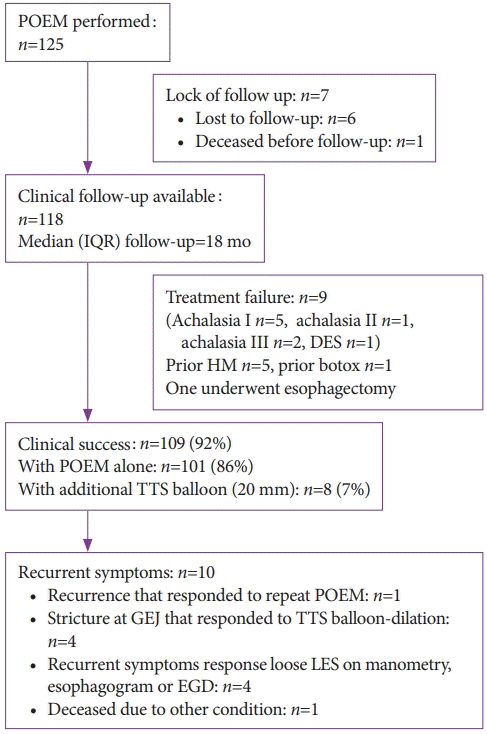
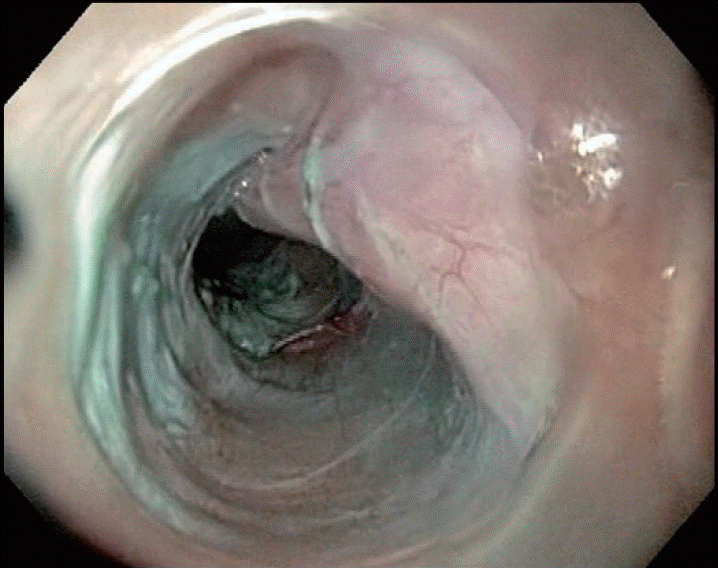
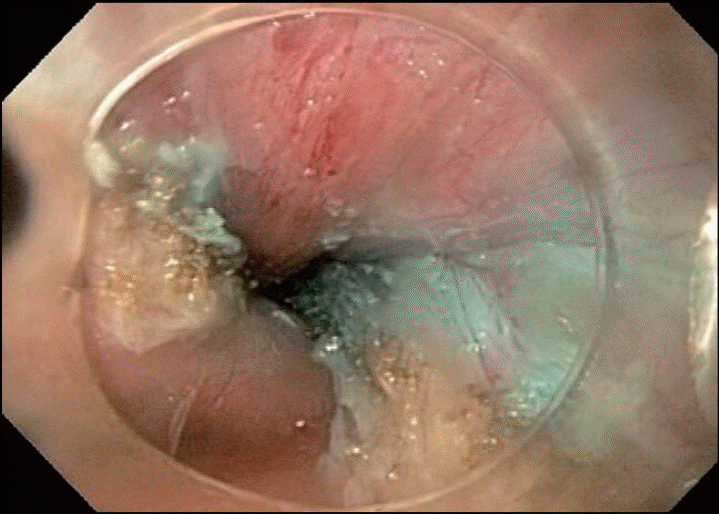
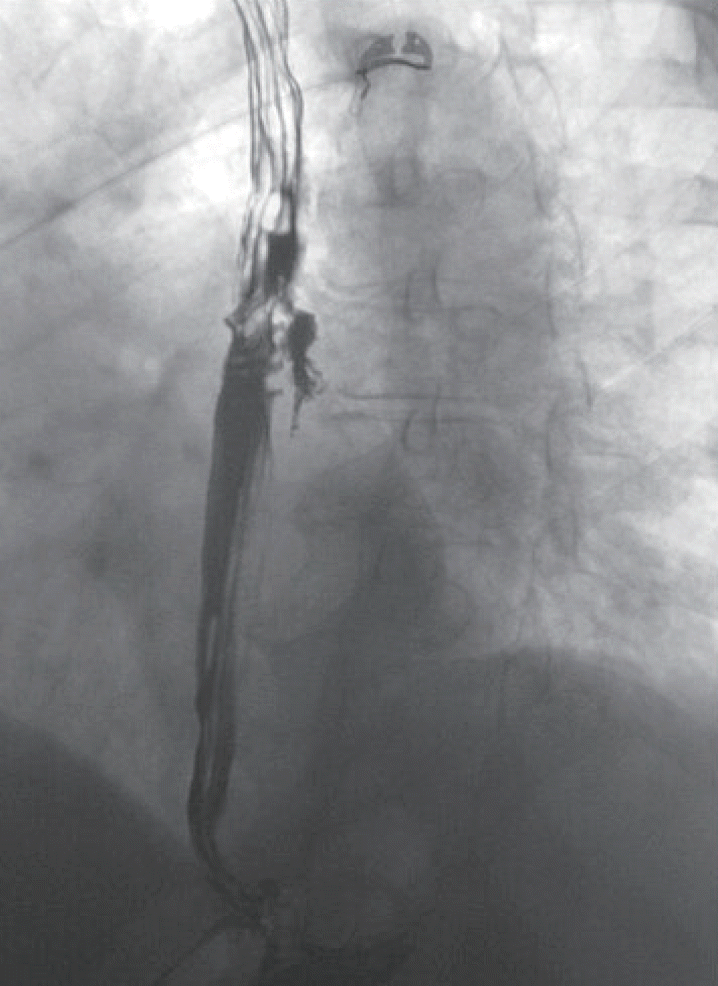
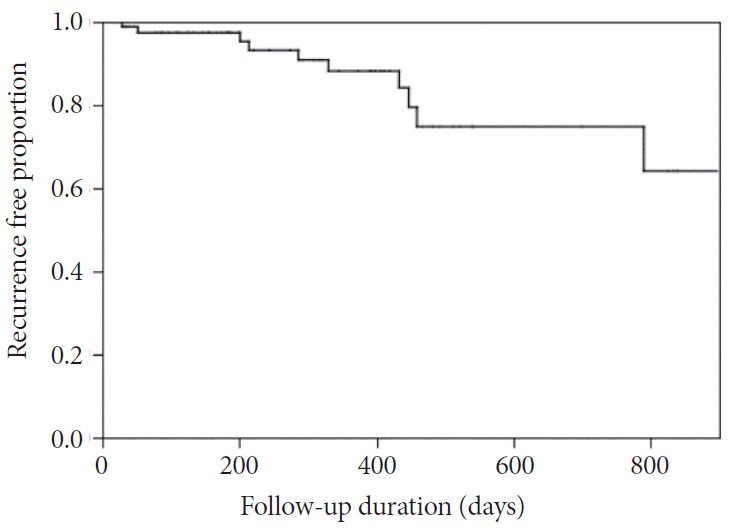
 XML Download
XML Download